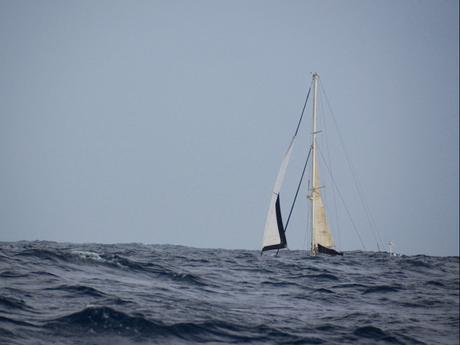
We thought we’d be in the Comoros by this morning, a string of islands between Mozambique and Madagascar; instead, we’re still 240 miles away and anchored. Exhausted from three rough days at sea, as our course passed in the lee of an uninhabited atoll in the outer Seychelles it was all too easy to decide to stop and rest.
This isn’t our worst passage, and not a storm we need sheltering from, but I’m a Dylan fan and can’t resist! On paper the conditions are active but manageable: winds averaging around 25 knots, forward of the beam with an apparent wind angle around 50-60 most of the time. Seas were mostly two to three meters, with the odd four meter set. Squalls of 30-35 knots formed quickly and frequently, but didn’t last long.
So why stop? The catch was the sea state, which was pretty uncomfortable. We’ve seen a lot of green water on the dodger the bow plunges and waves sweep back. The odd oversize wave has dumped on our beam, and left the boat shuddering. We’ve found every leaking hatch. And most importantly, we’ve struggled to sleep.
Going without sleep gets dangerous: being overly tired can result in poor judgment calls, or slower reflexes, or simply missing things that would be obvious to a rested person. Staying rested is one of the most important rules for being safe on a passage. We felt ourselves on the edge, and had the chance to make a change
In truth, I’m grateful for this gift of a last farewell to Seychelles. The outer islands were on my wish list, but the permit process for visiting them officially requires returning back to Victoria—you know, that place we left nearly 600 miles ago—to check out of the country. We thought they’d be impossible for us to visit, so while our bodies needed this, it’s also an offering for the spirit.
As we catch up on our sleep, make repairs from the passage, and wait for conditions to abate, there’s an opportunity to experience a completely different side of Seychelles. A pod of dolphins put on a show just behind the boat our first morning. Snorkeling along the shelf where we anchored, I’ve seen more variety and larger examples of turtles than anywhere we’ve cruised. Full stop. My first leatherback turtle sighting, and a green turtle that was as big as the table in our main cabin. A pair of curious snappers were nearly as big as Siobhan, and looked like they could have me for lunch if they wanted to!
Shore access is difficult. We anchor the dinghies at the fringe reef, then wade/swim in. The beach is lined end to end and some distance inshore with the big divots left by turtle nesting; the distinctive tire-track marks of a mama turtles journey to and from the sea is still written in the sand, and traced over by the much smaller prints of her hatchlings.
This atoll has been uninhabited for more than thirty years, but ruins from a small settlement remain. Literally millions of birds make Cosmoledo their home: it’s a rookery for several species of boobies, plus terns and tropicbirds and various waders. The boobies in particular are especially nosy and hover over Totem, occasionally get frighteningly close to our wind turbine.
The weather, our rest, and repairs should come together to allow us to depart tomorrow. Sailing south we’ll soon exit the big invisible box that Lloyds of London calls the High Risk Area, or HRA, for piracy in east Africa. We wouldn’t be here if we felt at risk, but situations change; it’s impossible to forget that these are waters we would never have considered transiting just a few years ago, and I’ll feel relieved when we leave that box behind.
This post is syndicated on Sailfeed.

